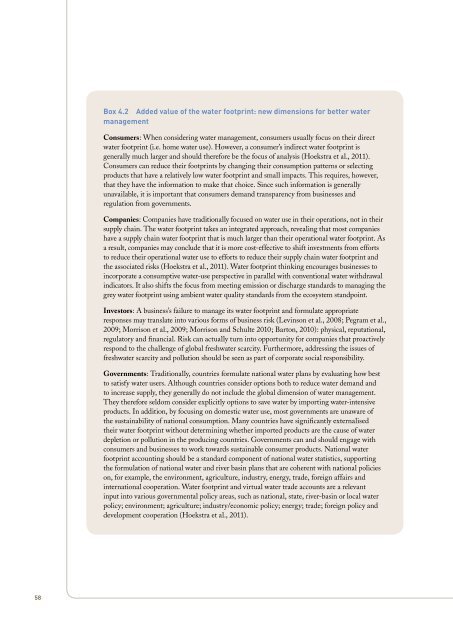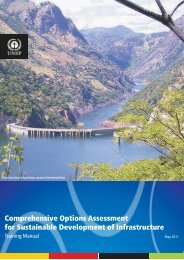MEASURING WATER USE IN A GREEN ECONOMY - UNEP
MEASURING WATER USE IN A GREEN ECONOMY - UNEP
MEASURING WATER USE IN A GREEN ECONOMY - UNEP
You also want an ePaper? Increase the reach of your titles
YUMPU automatically turns print PDFs into web optimized ePapers that Google loves.
Box 4.2 Added value of the water footprint: new dimensions for better water<br />
management<br />
Consumers: When considering water management, consumers usually focus on their direct<br />
water footprint (i.e. home water use). However, a consumer’s indirect water footprint is<br />
generally much larger and should therefore be the focus of analysis (Hoekstra et al., 2011).<br />
Consumers can reduce their footprints by changing their consumption patterns or selecting<br />
products that have a relatively low water footprint and small impacts. This requires, however,<br />
that they have the information to make that choice. Since such information is generally<br />
unavailable, it is important that consumers demand transparency from businesses and<br />
regulation from governments.<br />
Companies: Companies have traditionally focused on water use in their operations, not in their<br />
supply chain. The water footprint takes an integrated approach, revealing that most companies<br />
have a supply chain water footprint that is much larger than their operational water footprint. As<br />
a result, companies may conclude that it is more cost-effective to shift investments from efforts<br />
to reduce their operational water use to efforts to reduce their supply chain water footprint and<br />
the associated risks (Hoekstra et al., 2011). Water footprint thinking encourages businesses to<br />
incorporate a consumptive water-use perspective in parallel with conventional water withdrawal<br />
indicators. It also shifts the focus from meeting emission or discharge standards to managing the<br />
grey water footprint using ambient water quality standards from the ecosystem standpoint.<br />
Investors: A business’s failure to manage its water footprint and formulate appropriate<br />
responses may translate into various forms of business risk (Levinson et al., 2008; Pegram et al.,<br />
2009; Morrison et al., 2009; Morrison and Schulte 2010; Barton, 2010): physical, reputational,<br />
regulatory and financial. Risk can actually turn into opportunity for companies that proactively<br />
respond to the challenge of global freshwater scarcity. Furthermore, addressing the issues of<br />
freshwater scarcity and pollution should be seen as part of corporate social responsibility.<br />
Governments: Traditionally, countries formulate national water plans by evaluating how best<br />
to satisfy water users. Although countries consider options both to reduce water demand and<br />
to increase supply, they generally do not include the global dimension of water management.<br />
They therefore seldom consider explicitly options to save water by importing water-intensive<br />
products. In addition, by focusing on domestic water use, most governments are unaware of<br />
the sustainability of national consumption. Many countries have significantly externalised<br />
their water footprint without determining whether imported products are the cause of water<br />
depletion or pollution in the producing countries. Governments can and should engage with<br />
consumers and businesses to work towards sustainable consumer products. National water<br />
footprint accounting should be a standard component of national water statistics, supporting<br />
the formulation of national water and river basin plans that are coherent with national policies<br />
on, for example, the environment, agriculture, industry, energy, trade, foreign affairs and<br />
international cooperation. Water footprint and virtual water trade accounts are a relevant<br />
input into various governmental policy areas, such as national, state, river-basin or local water<br />
policy; environment; agriculture; industry/economic policy; energy; trade; foreign policy and<br />
development cooperation (Hoekstra et al., 2011).<br />
58

















